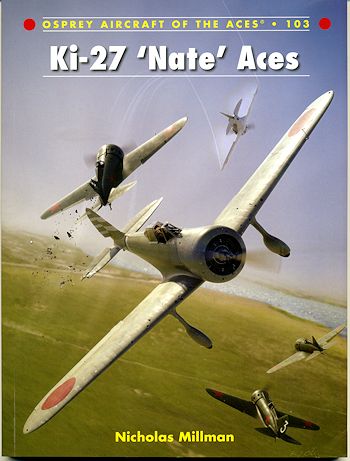 The most
important Japanese Army fighter on the eve of the Pacific War was the Ki-27. It
was an aircraft that was the first production monoplane fighter for that
service, replacing the Ki-10 biplane fighter. The Ki-27 was light, nimble and a
major improvement over the older biplane, despite sticking with fixed landing
gear. To the Japanese pilot, maneuverability was the main trait that every
fighter should have. This was left over from WWI and was hard for pilots to
think otherwise. Also left over from WWI was the rather anemic armament of two
rifle calibre machine guns.
The most
important Japanese Army fighter on the eve of the Pacific War was the Ki-27. It
was an aircraft that was the first production monoplane fighter for that
service, replacing the Ki-10 biplane fighter. The Ki-27 was light, nimble and a
major improvement over the older biplane, despite sticking with fixed landing
gear. To the Japanese pilot, maneuverability was the main trait that every
fighter should have. This was left over from WWI and was hard for pilots to
think otherwise. Also left over from WWI was the rather anemic armament of two
rifle calibre machine guns.
However, the Ki-27 was developed in that climate and it was felt that it would
do well in combat. Indeed, it did do well when fighting the Chinese in the late
1930s though it was more pilot skill than anything else. It was during the
Nomohan War with the Soviet union that the Ki-27 reached its pinnacle of
effectiveness. Japanese pilots racked up some pretty impressive scores against
the Soviets in the initial stages of the war. At this time the Soviets were
flying the I-15/153 and the I-16. In reality the I-16 was a superior aircraft
in terms of speed and ability to withstand punishment, but it was not fought
well. It wasn't until reinforcements in the form of Soviet units that had pilots
experienced in the Spanish Civil War that the tide started to turn. The lack of
speed was something that would continue to be an issue for Ki-27 pilots. The
Ki-27 could dogfight with the best of them, but once the enemy learned to use
hit and run tactics, the Ki-27 quickly became obsolete.
Despite this, the Ki-27 was still the main Army plane at
the start of the Pacific war. The Ki-43 was just entering service, but there
were not enough to equip everyone. So when the Japanese started fighting in
southeast asia, it was the Ki-27 that was the main army fighter. Just like in
Manchuria, the Ki-27 proved to be well suited to fighting the British, Dutch and
the AVG in the early going with several Ki-27 pilots racking up scores in
addition to their Nomohan totals. Again, once the opposition learned to do hit
and run tactics, the score totals reversed a bit, but by that time, it was too
late and the Japanese had overrun the are.
China in 1942 was the last effective use of the Ki-27.
With the introduction of the P-40E with its higher speed and greater
armor/armament, the Ki-27 was shown to be pretty well ineffective. In fact, most
of the fighter kills by the AVG were against the Ki-27, despite many pilots
calling them 'zeros' in their action reports. The Ki-27 was also pretty much the
only home defense fighter of the early war and it was this aircraft that made
several unsuccessful attacks on Doolittle B-25s during that raid. Even later in
the war, the Ki-27 was used against the B-29 in both Manchuria and over the
homelands. The only successes it had at that time was when the pilot
deliberately crashed his plane into the Superfortress. Most of its later years
were used as advanced trainers and late in the war as a suicide plane, piloted
by inexperienced teenage pilots.
Author Nicholas Millman does a superlative job of telling the
story of the men who flew the Ki-27. The Japanese side of the story during WWII
has been slow in coming and this book helps to fill a considerable void in that
knowledge here in the West. Superbly illustrated by what few photos have been
found of this aircraft as well as the excellent profiles we come to expect from
Osprey, it is a book that every enthusiast has to have on their shelves.
September 2013
For more on the complete line of Osprey books,
visit www.ospreypublishing.com. In the US, it is
Osprey Direct at 44-02 23rd St, Suite 219, Long Island City, NY 11101., where you can
get a catalogue of available books.
If you would like your product reviewed fairly and quickly, please
contact
me or see other details in the
Note to
Contributors.
 The most
important Japanese Army fighter on the eve of the Pacific War was the Ki-27. It
was an aircraft that was the first production monoplane fighter for that
service, replacing the Ki-10 biplane fighter. The Ki-27 was light, nimble and a
major improvement over the older biplane, despite sticking with fixed landing
gear. To the Japanese pilot, maneuverability was the main trait that every
fighter should have. This was left over from WWI and was hard for pilots to
think otherwise. Also left over from WWI was the rather anemic armament of two
rifle calibre machine guns.
The most
important Japanese Army fighter on the eve of the Pacific War was the Ki-27. It
was an aircraft that was the first production monoplane fighter for that
service, replacing the Ki-10 biplane fighter. The Ki-27 was light, nimble and a
major improvement over the older biplane, despite sticking with fixed landing
gear. To the Japanese pilot, maneuverability was the main trait that every
fighter should have. This was left over from WWI and was hard for pilots to
think otherwise. Also left over from WWI was the rather anemic armament of two
rifle calibre machine guns.